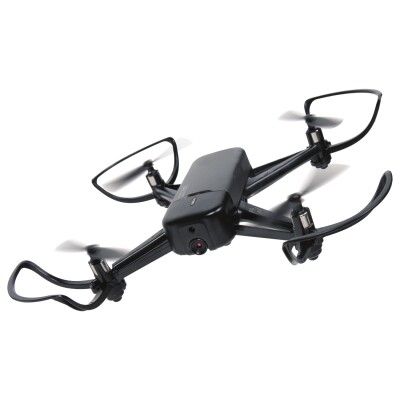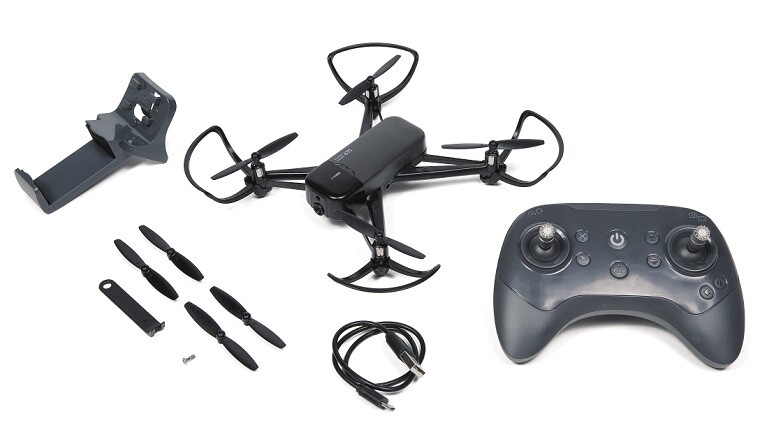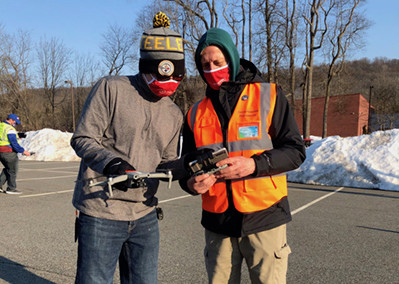More and more education professionals are discovering that drones are ideal platforms for teaching problem solving, critical thinking, and a variety of technical skills. To help advance the use of drones in education, Pitsco Education has introduced the Echo Drone. Aimed at learners in grades 6 – 12+, as well as at participants in clubs and competitions, the UAV offers features that make it adaptable to a number of educational applications.
The drone—which weighs 85 g. when in flight and measures 7 in. x 7 in.—offers a flight time of 10 minutes, making it ideal for indoor flying. Each low-cost Echo Drone comes with an R/C controller, but advanced operators can download an app to transition from R/C control to block-based or Scratch coding navigation.  The app also allows students and educators to use the drone’s onboard camera and transmit images and video to a smartphone via Wi-Fi. Moreover, the Echo Drone is Section 889-compliant, and the FAA does not require registration for the drone to be used.
The app also allows students and educators to use the drone’s onboard camera and transmit images and video to a smartphone via Wi-Fi. Moreover, the Echo Drone is Section 889-compliant, and the FAA does not require registration for the drone to be used.
To learn more about the Echo Drone, Commercial UAV News spoke with three leaders at Pitsco: Learning Specialist David Meador, Product Specialist Jaclyn Jenkins, and Product Marketing Coordinator Corinne Pachl. We discussed the drone’s features, how educators can adapt the vehicle for classroom use, and the ways students can benefit from working with drones.
Commercial UAV News: Discuss the features and capabilities of the Echo Drone and explain how they improve or contribute to educational programs.
Meador: Two big features we’re excited about are the Echo can be flown manually with the included R/C controller, and it can be coded. Echo’s 2.4 GHz radio controller is easily paired to the drone for manual flight. This means it is ready to fly out of the box, with no app downloads or separate purchases required, making it easy for students and educators to use. Each drone also comes with a device holder so you can attach a smartphone to the controller to easily view the camera feed and its telemetry information.
Also, Echo is compatible with Scratch, an MIT-developed coding system that allows students to learn the basics of programming, and you can use block-based code in the app download. Here, students can control the drone and execute various maneuvers, making learning to code concrete and engaging. This feature is particularly beneficial in STEM (science, technology, engineering, and mathematics) education, as it provides hands-on experience with coding and technology and connects to future careers.
Commercial UAV News: How is the Echo different than other drones used in educational settings?
Meador: Unlike other educational drones that connect to a controller via Wi-Fi, the Echo’s radio frequency connection allows for more than six drones to be in the air in limited space at the same time. This feature means the Echo can operate in environments where Wi-Fi interference would interfere with Wi-Fi controlled drones, such as in a classroom, in a gym, or at a SkillsUSA® competition. And, compared to many other drones with similar capabilities, Echo is affordable. For less than $200, you get the drone, its R/C controller, and extra parts. This makes it accessible for schools or educational programs that may have limited budgets but wish to incorporate cutting-edge technology into their curriculum.
Commercial UAV News: I understand you worked with educators during the development process. What kinds of input did they offer?
Jenkins: Pitsco is in constant communication with teachers about their classroom needs, and the conversation about drones is no exception. In the last few years, we’ve been researching the future of educational drones. Drone regulations are constantly discussed and passed, and, as we work to stay compliant, we have numerous conversations with teachers who use drones in their classroom. This helps us to identify what features they like, what they would change about the drone they use, and what kinds of support materials they need. In the case of the Echo, we utilized all that research and knowledge to develop the hardware. Our Flight Guide drone curriculum that can be used with the Echo was written in-house and tested by local educators and students.
Commercial UAV News: DJI’s decision to stop selling education-focused drones also factored into the development of the Echo Drone, is that correct?
Jenkins: Prior to the Echo, we had been a seller of DJI’s educational drones since 2020, but then DJI announced they would no longer manufacture such drones. We knew we needed to provide educators with a quality, affordable alternative. We found that this was an opportunity to improve upon what drones are available in the market—we had high expectations for our drone’s capabilities and knew what to prioritize based on our history of using drones in education. We’re proud we have produced a drone while keeping teachers, classrooms, and competitions in mind and that it addresses educator concerns—it can fly without Wi-Fi interference issues and without the use of a phone. It’s small enough to be flown indoors and does not require registration with the FAA. Plus, we’re excited it is compliant with NDAA Section 889; this means educators may be allowed to purchase and fly it for schools nationwide.
Commercial UAV News: How can classwork involving drones help students gain employable skills? Can you give some examples?
Pachl: Drone use is a huge opportunity to develop employability skills while students are in school, partially because they’re so fun and engaging. Employers are looking to hire someone with both technical skills and soft skills, such as drone safety knowledge, flight experience, and the ability to problem-solve and work alongside coworkers—and students actually practice these skills as they prep for the FAA Part 107 test. A desire to learn, adaptability, and communication are strengths applicable to all industries, and we see drones as a perfect tool to introduce and develop such skills.
Meador: Throughout Pitsco’s drone curriculum content, students are exposed to different career pathways that utilize drones in their day-to-day tasks. Students explore what skills are necessary in that career field – both technical skills and soft skills—and they then put those skills into practice by completing hands-on drone activities that model skills specific to the career they are exploring. For example, drone education utilizes technical skills including efficient flight planning; maintaining safe operations in restricted air space; documenting and reporting specific information through written reports, photographs, and video; and completing preflight and post flight checks of all equipment.
Also, students work in teams of two to four students to plan, execute, and report on all the posed missions, requiring collaboration, role fulfillment, and effective communication at all levels. The technical skills are based on industry-standard practices used in different career fields. The soft skills are transferable to all future career areas.
Commercial UAV News: Given the value this form of education has to employers, have any companies worked with you on designing the drone or on the related curriculum?
Meador: Pitsco works with a variety of professionals in business and industry to ensure that the products and curriculum we develop are relevant to workforce needs. Such feedback can come directly from educators who used to work in drone industry/serve in the military, committee members for national career and technical education (CTE) clubs such as TSA or SkillsUSA, or partners like CrossFlight Sky Solutions and DroneBlocks who specialize in industry knowledge for their programs. We utilize feedback from these professionals to help guide our decision-making and focus our development efforts both on physical hardware and in curriculum. We also use their expertise to test and refine products as we bring them to the field.
Commercial UAV News: What’s next for Pitsco? Are there new products or enhancements in the works?
Jenkins: Pitsco always has new projects in the works! We are excited by the potential of our current drone continuum—from the Grades 3-8 Drone Maker Kit to the Echo to high school FAA Part 107 certification training—and we’re always looking to see how we can utilize drones in new ways. In fact, we are currently scheduling beta testing for our next drone project that is in the pipeline. I believe this new product will transform the way drone education is taught, and I can’t wait to see how it pushes students to succeed. Stay tuned!















Comments